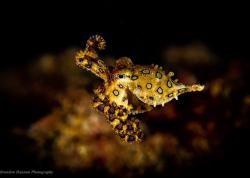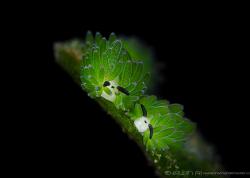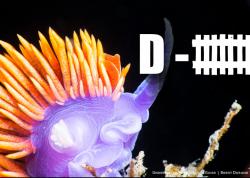Navigating the Kelp Forest Safely Underwater and Still Getting that Great Shot
Beginners Guide to Navigating the Kelp Forest Safely and Still Getting that Great Shot
Tips and tricks on how to get some great underwater photos in the maze that is the kelp forest.
Text and images by Jonathan Lavan

Divers underwater at San Clemente Island, Southern California
Cold water diving can be challenging. Lots of bulky equipment, extra weight and strong currents and surge can make even taking a camera along a difficult prospect. Then add the element of navigating the kelp forest it can get downright nerve wracking.
Whether boat diving or shore diving never just descend into the middle of the kelp forest. That might seem like an obvious instruction but you’d be alarmed how many dives I have been on where, supposedly, seasoned west coast divers have gotten so tangled up in the kelp that they have lost their fins or their buddy has had to spend more than half of the dive extricating them from their entanglement. Any self respecting boat captain will, hopefully, always place you near the edge of the kelp forest anyway.

Photo 1: Spanish Shawl Nudibranch
Buoyancy in the kelp
You’re told when diving dry to only use your drysuit to regulate your buoyancy at depth and only use your BCD at the surface. That’s fine for straight diving but when using your camera you should use whatever combination of drysuit and BCD that gives you the best buoyancy control. Just remember to deflate both sources before surfacing. I always put just enough air in my drysuit to be comfortable and then control my buoyancy as usual with my BCD. It’s always easier to get that shot when air isn’t rushing up into your feet!

Photo 2: Red Sea Star on California Hydrocoral
Navigating underwater
Now, you need to convince your SLR that it’s a compact. Keep those strobe arms in tight until you’re ready to set up the shot. When travelling hold your camera sideways to navigate the kelp easier. Go even slower than you would normally. If you get tangled-stop-untangle and move on with your buddy’s assistance if necessary. Vis can vary greatly so, even more so then warm water diving, it is quite important to keep your buddy within arm’s length in this environment.

Photo 3: Whitespotted Rose Anemone & Feather Duster Worms
Sealions at the edge of the kelp forest in Anacapa
The Edge of the Kelp
You will find plenty of great shots around the edges of the forest anyway and there will be more available light. There are many more colors and contrasts, especially among invertebrate life, in the cold water, then you might initially realize. Particularly nudibranchs (photo 1) and sea stars (photos 2) but also a wide variety of crustaceans of all sizes, sea anemones and various tube worms as well. As can be seen in photo 3 of the sea anemone and feather duster worms there is often a great deal of movement in the water typically known as surge.

Photo 4: Brittle Star
Dealing with Surge
Unlike the Caribbean or other warmer Pacific waters where there may be some current to push you along, surge is a different phenomenon pulling you both back and forth. The best thing to do is “go with the flow”. Prep the shot, and as you are pulled back into frame by the surge, grab the snap. If the surge isn’t too bad you can get some interesting and artful shots this way. Bokeh is all the rage of late and the movement and vibrancy in the shot can more than make up for whatever detail of focus is sacrificed.

Photo 5: Threespine Shrimp

Photo 6: Giant Acorn Barnacle, Strawberry Anemones
Super Macro
Try to familiarize yourself with both the fish and inverts, in advance of your dives, so you have some idea of what you’re looking for. If at all possible, dive with someone with local experience who can lead you to the best shots. Super macro opportunities abound in the kelp forest as well. I never would have known the beautiful colors and patterns of this tiny Brittle Star (photo 4) if not for my magnifying diopter. The tiny Threespine Shrimp in photo 5 (there are two of them there) are virtually transparent so I was fortunate that I could readjust my angle so one of them was along the edge of the rock when I grabbed the shot so it could be clearly seen against the dark background. Giant Acorn Barnacles (photo 6) are another cold water creature worth a shot. Their large size and the fact that you have to catch them when their feeding arms are out makes for a fun challenge. Frequently, as in this shot, they are surrounded by other beautiful inverts like these Strawberry Anemones.

Photo 7: Gopher Rockfish over Whitespotted Rose Anemone

Photo 8: Rosy Rockfish
The Fish
While fish are not as plentiful as in warmer waters there are still many opportunities for great photos to be had. Rockfish (members of the Scorpionfish family) come in many varieties and are slowly bouncing back from severe overfishing over the last several decades. The great thing about rockfish is that they just hang there. A fine example of this is (photo 7) of the Gopher Rockfish hovering over a Whitespotted Rose Anemone. The colorful Rosy Rockfish in (photo 8) is usually found at depths below 100 feet and near the base of ledges so best to look for them toward the start of your dive. Kelp Rockfish (photo 9) are more wary so there are usually a few good “peek-a-boo” shots to be taken.

Photo 9: Kelp Rockfish
In sandy areas you can find Blackeye Gobies (photo 10) which have the curious habit of resting on Bat Stars and if you’re lucky you might stumble on the face only a mother could love: the Wolf Eel (photo 11). They spend as much of their day as they can eating sea urchins to no ill affect, a photo I hope to get in the near future. Lastly there are a great variety of Sculpin all of which are very hard to tell apart. Usually quite small and skipping around the rocks they are often hard to see and even harder to get a good shot of. This Coralline Sculpin with the Red Volcano Sponge for a background (photo 12) is one of those rare shot that is the exception not the rule.

Photo 10: Blackeye Goby on Bat Star

Photo 11: Wolf Eel
Final Thoughts
In closing, I would say if you have never experienced the cold and dynamic waters of the west coast and are looking for a new and challenging dive experience then grab that drysuit and dive in! Some truly amazing animals await you and as long as you are cautious, patient and dive smart there are many unforgettable photos to be taken. The post dive cocoa has never tasted so good…

Photo 12: Coralline Sculpin on Red Volcano Sponge
About the Author
 Jonathan Lavan is the owner/operator of Underpressure Diving and Photography and an online fish ID instructor for the Reef Environmental Education Foundation (reef.org). He shoots with a Nikon D300 with a 60mm or 105mm lens in a Subal housing, a ReefNet 10+ magnifying diopter, Ikelite 125’s or 160’s for strobe and a Light & Motion SOLA/PHOTO 500 focus light. He can be reached at jonathan_maureen@yahoo.com. His work can be seen at www.underpressure-spurdog.blogspot.com, www.underpressurephotographybest.blogspot.com and at Underpressure Photography on Facebook.
Jonathan Lavan is the owner/operator of Underpressure Diving and Photography and an online fish ID instructor for the Reef Environmental Education Foundation (reef.org). He shoots with a Nikon D300 with a 60mm or 105mm lens in a Subal housing, a ReefNet 10+ magnifying diopter, Ikelite 125’s or 160’s for strobe and a Light & Motion SOLA/PHOTO 500 focus light. He can be reached at jonathan_maureen@yahoo.com. His work can be seen at www.underpressure-spurdog.blogspot.com, www.underpressurephotographybest.blogspot.com and at Underpressure Photography on Facebook.
Further Reading
-
All about Giant Kelp Forests
-
Diving Catalina Island
-
Diving the Channel Islands
-
Guide to Marine Life
-
California Marine Life
Where to Buy
Please support the Underwater Photography Guide by purchasing your underwater photography gear through our sister site, Bluewater Photo & Video. Click, or call them at (310) 633-5052 for expert advice!
RECOMMENDED ARTICLES
SUPPORT THE UNDERWATER PHOTOGRAPHY GUIDE:
The Best Service & Prices on u/w Photo Gear
 Visit Bluewater Photo & Video for all your underwater photography and video gear. Click, or call the team at (310) 633-5052 for expert advice!
Visit Bluewater Photo & Video for all your underwater photography and video gear. Click, or call the team at (310) 633-5052 for expert advice!
The Best Pricing, Service & Expert Advice to Book your Dive Trips
 Bluewater Travel is your full-service scuba travel agency. Let our expert advisers plan and book your next dive vacation. Run by divers, for divers.
Bluewater Travel is your full-service scuba travel agency. Let our expert advisers plan and book your next dive vacation. Run by divers, for divers.

































